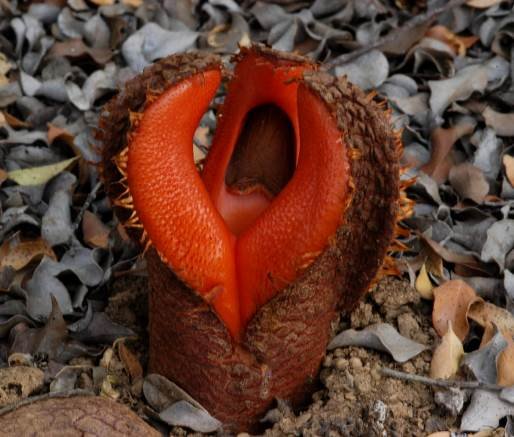Hydnora africana flower

Author: Ivan Lätti
Photographer: Louis Jordaan
Hydnora africana appears above-ground as a bud only when its bisexual flower develops. It starts off below ground, bulging free after rain during winter and until after midspring. The rain dependent flower may appear only after years of the plant’s life and a bud takes a year or two to develop into a fruit.
The flower is near spherical, brown on the outside and bright salmon or orange with some white inside. The three or four perianth lobes are thickly fleshy, sponge-cushioned, the tube up to 2 cm wide. These lobes tear apart vertically gradually, exposing stiff bristles along the inside of the perianth lobe skin.
The pale bristles ensnare carrion insects. They are lured by the putrid smell secreted by the white bait bodies inside the lobe skins, eaten by the insects. Trapped by the bristles, the wriggling insects become covered in pollen from the stamens, depositing this onto the stigma, thus pollinating the flower and die or escape when the bristles wither.
The fruit is a thick-skinned underground berry about 8 cm wide, containing up to 20 000 very tiny seeds embedded in an edible, gelatinous pulp. The pulp tastes like potato, eaten by people, baboons, jackals, porcupines, birds and more.
A germinated seed near a Euphorbia root develops its primary root or haustorium, which attaches to the host plant’s root, followed by numerous secondary root attachments over time (Pooley, 1998; Bond and Goldblatt, 1984; iNaturalist; http://pza.sanbi.org).

